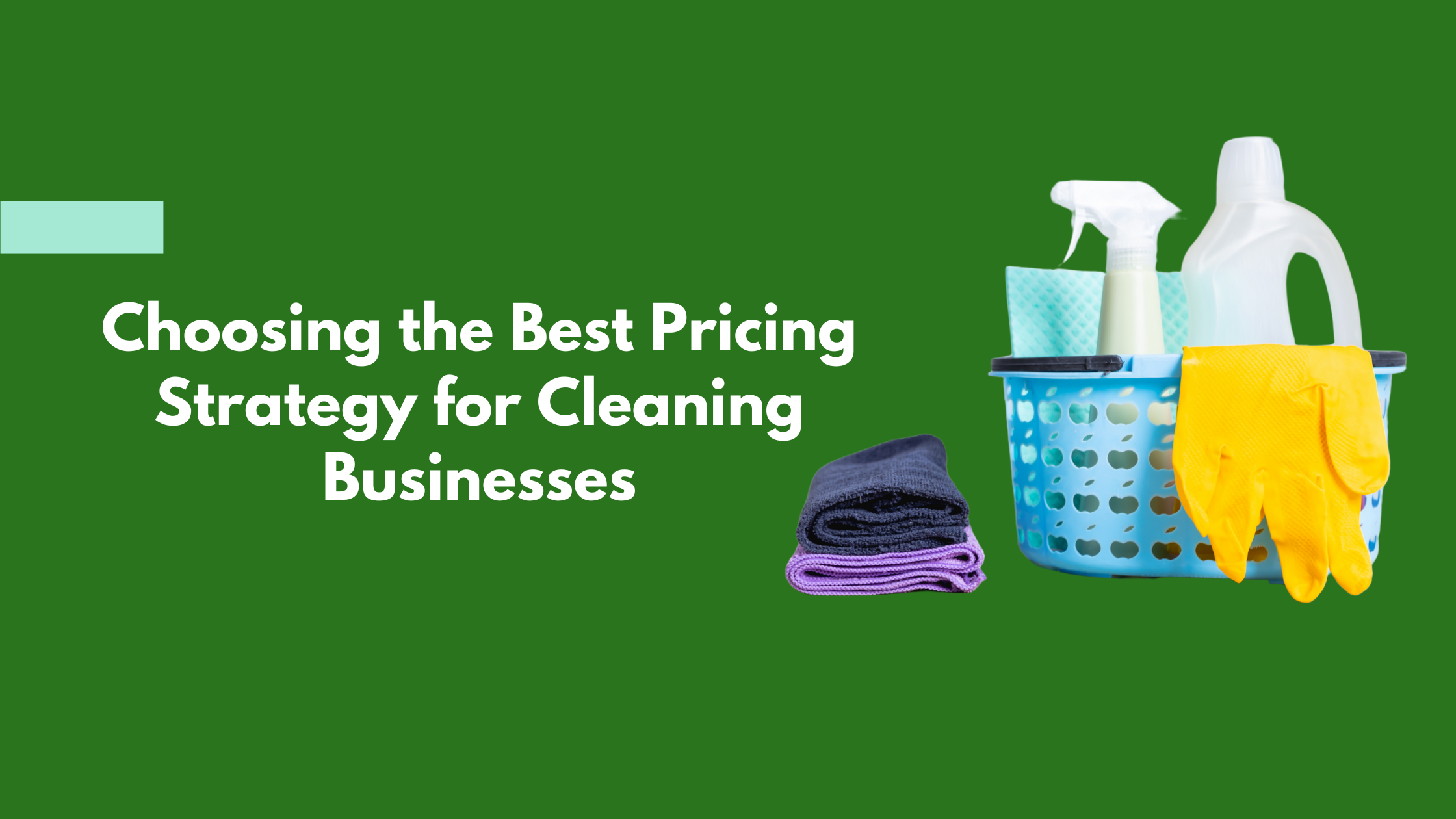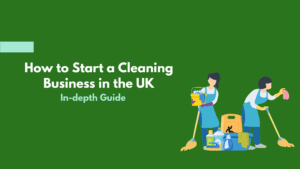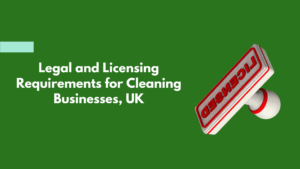Pricing is one of the most important decisions you’ll make when starting your cleaning business. If you set your prices too low, you’ll struggle to cover costs or turn a profit. If your prices are too high, you risk losing customers to competitors.
Many cleaning businesses fall into common pricing traps, like undercharging to win clients or using a pricing model that doesn’t account for hidden costs like transportation, equipment maintenance, and employee wages. This means that a poorly structured pricing strategy can quickly eat into your profits.
But what is the best pricing strategy for cleaning businesses? In this guide, we’ll break down the different pricing strategies used in the cleaning industry, the key factors to consider when setting your rates, and how to calculate prices that ensure profitability. By the end, you’ll have the knowledge to confidently set a pricing structure that works for your business and keeps your clients coming back. Let’s get started.
Table of Contents
What Are the Different Pricing Strategies for a Cleaning Business?
There are about 5 different pricing strategies that you can incorporate into your cleaning business. They include:
1. Hourly Pricing
2. Flat-Rate Pricing
3. Per-Room and Per-Square-Foot Pricing
4. Tiered Pricing
5. Subscription-Based Pricing
Let’s look at them in detail.

1. Hourly Pricing Strategy
Hourly pricing is one of the most straightforward and flexible pricing strategies for cleaning businesses. It allows you to charge clients based on the actual time spent cleaning rather than a fixed rate per job.
This approach works well when the scope of work varies significantly from one client to another or when unexpected tasks may arise during the cleaning process.
By charging per hour, you ensure that you are compensated fairly for your time and effort, particularly for jobs that take longer than anticipated. It also helps build transparency with your clients since they pay only for the time spent on their premises.
One of the biggest advantages of hourly pricing is its adaptability. If a client requests additional services, such as deep cleaning or stain removal, you can extend the time spent on-site without renegotiating a fixed price.
This pricing model is also beneficial when handling new clients who may not yet know the exact level of cleaning they need. Instead of underpricing a job based on a rough estimate, you can let the work dictate the final cost.
However, it is crucial to set a competitive hourly rate that reflects the quality of your service, covers your labor and operational costs, and ensures profitability. The average cleaning charge is about £22 per hour in the UK, and may be higher depending on location, experience, and service level.
While hourly pricing offers flexibility, it does come with challenges. Some clients may be hesitant to agree to an open-ended pricing model because they fear the final cost will exceed their budget. Others may feel dissatisfied if they believe time is being wasted.
One way to address this is by offering an estimated number of hours upfront and maintaining accountability by tracking time accurately. Using time-tracking software or simply keeping a detailed record of hours worked can help avoid disputes and ensure fair billing for both you and the client.
In high-demand urban areas, where labor costs and living expenses are higher, hourly pricing can be a strong revenue generator if priced correctly. However, in areas where price sensitivity is high, some clients may prefer a flat rate to avoid uncertainty.
So to make hourly pricing work in your favor, it’s essential to monitor your competitors’ rates, adjust based on demand, and ensure that your service quality justifies the price you charge.
2. Flat-Rate Pricing Strategy
Flat-rate pricing is another effective pricing strategy for cleaning businesses. Instead of charging by the hour, you set a fixed price for each service, giving customers clarity and predictability. This eliminates uncertainty, helping build trust while making it easier to sell your services.
For your business, flat-rate pricing improves efficiency and profitability. Unlike hourly rates, which can incentivise slow work, a fixed price encourages you to optimise processes and train staff effectively. With the right systems in place, you can complete jobs faster, serve more customers, and increase revenue without raising prices.
However, to implement this model successfully, you need a solid understanding of your costs including labour, supplies, equipment, travel, and overheads. Market research is also crucial. With over 66,000 cleaning businesses operating in the UK, setting competitive yet profitable rates is essential. Many businesses use past job data to determine average cleaning times, ensuring prices fairly reflect the work involved.
In addition, managing customer expectations is key. Some assume a flat rate means unlimited work, so clear service descriptions are necessary. Many businesses offer pricing tiers based on property size and condition, preventing underpricing for more demanding jobs.
Flat-rate pricing also supports upselling. Once customers accept a base price, they’re more likely to add extras like oven cleaning or carpet shampooing. From a marketing perspective, fixed pricing makes advertising easier and reduces pricing inquiries, allowing you to focus on bookings.
When done correctly, flat-rate pricing streamlines operations, enhances customer satisfaction, and increases profitability. It’s a powerful strategy that balances simplicity and efficiency, ensuring long-term success for your cleaning business.
3. Per-Room and Per-Square-Foot Pricing Strategy
Per-room and per-square-foot pricing are two other widely used methods for setting cleaning service rates in the UK, and each comes with its own advantages and drawbacks. Selecting the right approach depends on the type of properties you clean, your operational costs, and market expectations.
Per-room pricing is straightforward, making it a popular choice for residential cleaning. Each room type, such as kitchens, bathrooms, and living areas,is assigned a set price based on the average time and effort required. This method makes quoting easy for both you and the client, ensuring transparency.
However, it doesn’t always account for variations in room size or level of dirt. A small guest bedroom and a large master bedroom might be priced the same, even though one takes significantly longer to clean.
Additionally, heavily soiled rooms can take twice as long to clean as an average one, reducing your profit margins if you don’t adjust accordingly.
Per-square-foot pricing, often used for commercial spaces and larger homes, ensures a more precise reflection of workload. It allows you to charge proportionally for bigger spaces, making it ideal for deep cleans or large contracts.
The major downside here is that per-square-foot-pricing requires more calculations and may be harder for clients to understand upfront. Some businesses also find that smaller jobs become less profitable under this model, as they may not meet the minimum call-out cost.
In the UK, residential cleaning rates typically range from £15 to £25 per room, depending on location and the level of service. Per-square-foot rates vary, but commercial cleaning usually falls between £0.10 and £0.30 per square foot.
Finding the right balance between these pricing models will help maximise profitability while ensuring clients feel they are getting fair value.
4. Tiered Pricing Strategy
Tiered pricing allows you to cater to different customer needs while maximising revenue. Instead of offering a one-size-fits-all service, you create multiple pricing levels based on factors such as frequency, service depth, and add-ons. This increases your potential customer base and encourages higher spending.
Let’s say you operate a domestic cleaning business. A basic package might include general tidying, vacuuming, and surface cleaning. A mid-tier option could add deep kitchen and bathroom cleaning. A premium service might include extras like oven cleaning, window washing, or even laundry services. Structuring your pricing this way helps your business appeal to budget-conscious clients.
The key advantage of tiered pricing is that it shifts the customer’s decision from “Should I book?” to “Which package should I choose?” This psychological shift increases conversions and reduces price resistance.
However, tiered pricing also has its drawbacks. Managing multiple service levels increases complexity, and customers may feel overwhelmed by too many choices or frustrated if lower tiers seem inadequate.
Additionally, incorrectly pricing tiers can lead to underpricing premium services, reducing profitability and perceived value.
To counter this, ensure each tier offers clear value and aligns with customer expectations. Next, use strategic pricing to make the mid-tier most attractive while keeping premium options desirable.
Also regularly review performance to adjust offerings.
When done right, tiered pricing boosts revenue, enhances customer satisfaction, and strengthens your market position.
5. Subscription-Based Pricing
Subscription-based pricing is also an excellent pricing strategy for cleaning businesses in the UK, because it offers predictable revenue and long-term customer retention.
With this model, you charge clients a fixed, recurring fee weekly, biweekly, or monthly, in exchange for ongoing cleaning services. This approach works particularly well for domestic and commercial cleaning, where clients value consistency and convenience.
One of the biggest advantages is financial stability. Instead of relying on one-off jobs, you secure a steady income stream, which helps with cash flow management and long-term planning. Clients also benefit, as they don’t have to book services repeatedly; they simply pay a set amount and receive regular cleanings without hassle.
Additionally, it simplifies your operations since you can better predict demand and manage staff scheduling accordingly.
However, one issue about subscription-based pricing is customer commitment. While some appreciate fixed pricing, others may hesitate to commit long-term, especially if they feel they don’t need cleaning services as frequently as the subscription requires. Managing cancellations can also be tricky, as you must establish clear terms to prevent financial losses.
Despite these challenges, when structured correctly, subscription-based pricing can provide strong financial benefits, enhance customer retention, and create a scalable, predictable business model.
Key Factors to Consider When Setting Prices for Your Cleaning Business
Here’s what you need to consider when setting your prices.

Understand Your Costs
Before setting any price, you need to know how much it costs to run your cleaning business. The biggest mistake many cleaning businesses make is setting prices without fully accounting for all expenses.
Labor costs are the biggest factor, making up about 50% to 60% of a cleaning company’s total expenses. This includes wages, payroll taxes, and employee benefits. If you have employees, their pay should be factored into your pricing to ensure you remain profitable.
Supplies and equipment are another major expense. Even if you use basic cleaning supplies, costs can add up quickly over time. If you offer eco-friendly or specialized cleaning products, your expenses may be higher, and your pricing should reflect that added value.
Transportation costs must also be considered, especially if you service clients in multiple locations. Fuel, vehicle maintenance, and insurance all contribute to your overall costs.
Beyond these direct costs, you should also account for overhead expenses, such as marketing, licensing, software for scheduling and invoicing, and business insurance.
Many business owners overlook these costs, only to realize later that they’re making far less profit than they expected. The best approach is to calculate your total monthly expenses and divide that by the number of jobs you complete each month. This gives you a clear baseline for how much you need to charge per job just to break even.
Research Your Market
Understanding what other cleaning businesses charge in your area is crucial. Pricing too low might attract clients, but it can also make you look less professional. On the other hand, setting prices too high without offering additional value can drive potential customers away.
Researching your competitors helps you see where your pricing should fall and what value you need to offer to justify your rates.
To do this, start by looking at cleaning businesses similar to yours, those that offer the same type of services, target the same customers, and operate in the same area.
Many businesses list their pricing on their websites, but if they don’t, you can call as a potential customer to inquire about their rates. Pay attention not just to their prices but also to what’s included in their services. Are they offering basic cleaning, deep cleaning, or specialized services? Do they charge extra for add-ons like carpet cleaning or appliance cleaning?
You should also consider the demand for cleaning services in your area. In cities where cleaning services are in high demand, businesses can charge more, while in smaller towns, pricing might need to be more competitive.
Define Your Target Audience
Who you are targeting plays a huge role in how you price your services. If your goal is to serve budget-conscious clients, your pricing should be lower, but you’ll need to focus on volume to stay profitable.
However, if you are targeting high-end clients who prioritize quality and convenience, you can charge premium rates. The key is to match your pricing to the expectations and willingness of your ideal clients.
For residential cleaning, clients typically fall into three categories: budget-conscious, mid-range, and high-end. Budget-conscious clients prioritize affordability and may be drawn to hourly or per-room pricing. Mid-range clients expect a balance of affordability and quality, making flat-rate or tiered pricing a great option. High-end clients want premium services, such as eco-friendly cleaning, same-day appointments, or specialized deep cleaning, and they are willing to pay extra for it.
For commercial cleaning, pricing should reflect the scale and complexity of the job. Small businesses and offices may prefer per-square-foot pricing, while larger corporate clients often negotiate contracts based on service frequency.
Many commercial clients look for long-term partnerships, so offering discounts for ongoing contracts can be a smart pricing strategy.
Factor in the Value You Provide
Price should not just be based on costs, it should reflect the value you bring to your clients. If you use high-quality cleaning products, have highly trained staff, or offer a better customer experience, your prices should reflect that.
Many businesses undercharge because they fear losing clients, but the reality is that people are willing to pay more for better service.
If you’re using eco-friendly or non-toxic products, make that a selling point. Studies show that 64% of consumers are willing to pay more for eco-friendly services.
If you have trained and insured employees rather than independent contractors, highlight that as well. Clients appreciate the security of knowing they’re hiring a professional and reliable service.
Your pricing should also consider factors like response time and flexibility. If you offer same-day or emergency cleaning services, charge a premium for those. If you operate on weekends or holidays, factor that into your rates.
The more convenience and customization you offer, the more justified higher pricing becomes.
Adjust for Seasonal Demand
Cleaning businesses often see fluctuations in demand depending on the time of year. For example, demand typically increases during spring cleaning season, before the holidays, and at the end of lease periods. Many businesses adjust their pricing during these peak times to maximize revenue.
Offering seasonal promotions or packages can help balance demand. For example, you can introduce spring deep cleaning specials or offer discounted rates for first-time customers during slower months.
If demand is particularly high, implementing surge pricing for last-minute bookings can be a profitable strategy.
Review and Update Prices Regularly
Your pricing should not remain static. As costs increase due to inflation, rising wages, or higher supply costs, your rates should be adjusted accordingly. Many cleaning businesses fail because they set their prices once and never update them, eventually struggling with shrinking profit margins.
Review your pricing at least once a year to ensure it remains competitive and profitable. If you notice an increase in expenses or demand for your services, adjust your rates.
When increasing prices, communicate the change clearly to your clients by highlighting added value, such as improved cleaning products, better-trained staff, or expanded service options.
Testing and Refining Your Pricing Strategy
Setting the right prices for your cleaning business isn’t a one-time task, it’s an ongoing process that requires regular testing and adjustments. Market conditions change, customer expectations evolve, and your business costs may fluctuate.
To keep your pricing competitive and profitable, here’s a structured approach to testing and refining your rates.
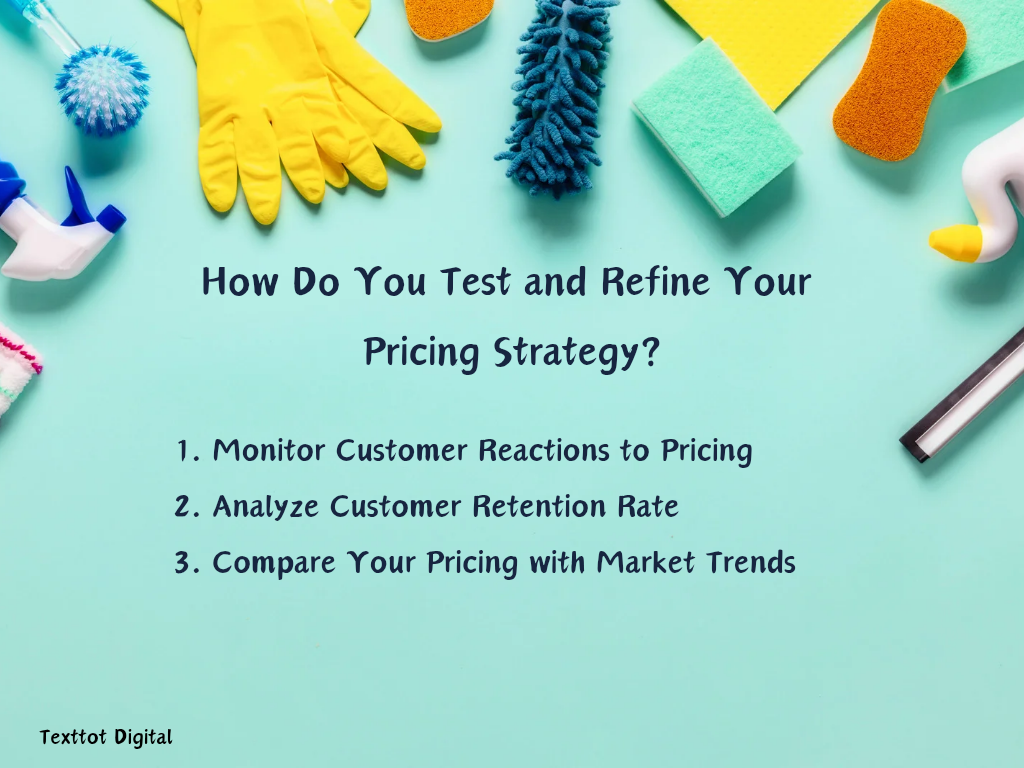
Monitor Customer Reactions to Pricing
The first sign that your pricing may need adjustment comes from customer feedback and behavior. If you’re struggling to convert leads into paying clients, your pricing could be a factor.
When potential customers frequently ask for discounts, delay decisions, or choose competitors with lower rates, it’s a sign that your pricing may not align with their expectations.
On the other hand, if nearly every customer accepts your rates without hesitation, you might be pricing too low and leaving money on the table.
One effective way to gauge customer reaction is through A/B testing. This involves offering slightly different pricing models to different groups of customers to see which performs better.
For example, you might test whether more customers prefer an hourly rate versus a flat-rate service. If one model consistently leads to more bookings or higher customer satisfaction, it’s a strong indicator that you should adopt that pricing approach permanently.
Analyze Customer Retention Rate
Another way to assess pricing effectiveness is by analyzing your customer retention rate.
If existing clients frequently cancel services or switch to competitors, your pricing or service value might not be aligned with what they expect.
Retaining customers is often more cost-effective than constantly acquiring new ones, so ensuring your pricing supports long-term relationships is key.
Compare Your Pricing with Market Trends
Your pricing should not exist in isolation, it should be competitive within your market. Keeping an eye on industry trends and competitor pricing helps you stay relevant without being underpriced or overpriced.
If similar cleaning businesses in your area are raising their prices due to inflation or increased demand, you may need to follow suit to maintain profitability.
One way to conduct a pricing analysis is by gathering information from competitor websites, customer reviews, and industry reports. If your pricing does not reflect local market conditions, you may either be missing out on higher earnings or struggling to attract cost-conscious clients.
However, it’s important to differentiate your services beyond price alone. Competing solely on price can lead to a race to the bottom, where businesses undercut each other to the point of unsustainable margins.
Instead, focus on value-based pricing, emphasizing unique selling points like eco-friendly products, highly trained staff, or flexible scheduling. Customers are often willing to pay more for services that offer added benefits.
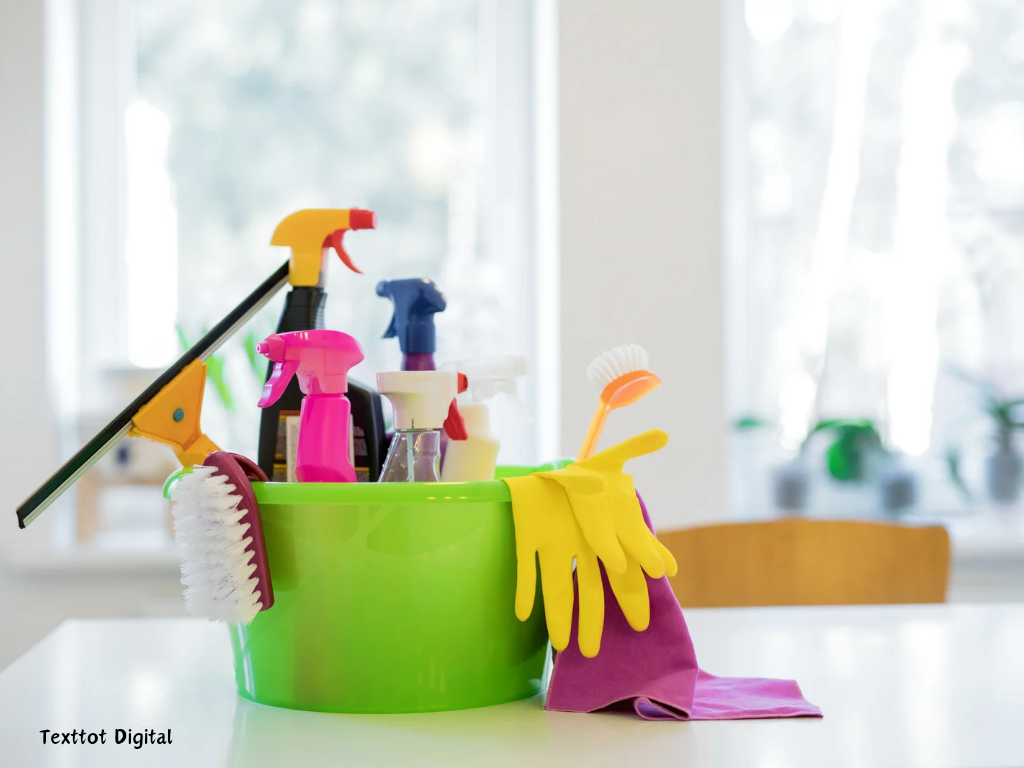
How to Adjust Prices for Your Cleaning Business Without Losing Customers
Raising prices can be a sensitive topic, especially if you have long-term clients who are used to a certain rate.
However, as your business grows and operational costs increase, price adjustments are necessary to maintain profitability. The key is to implement changes strategically while keeping customer trust intact.
One effective approach is gradual price increases. Instead of suddenly raising prices by 20%, consider smaller increments over time. For example, a 5% increase every six months allows customers to adjust without feeling like they’re being overcharged. Customers are less likely to resist small, incremental changes compared to a large, sudden jump in pricing.
Transparency is also crucial when raising prices. If you need to increase rates, communicate the reason clearly. For instance, if you’ve invested in better equipment, improved training for staff, or expanded your service offerings, explain how these enhancements benefit the customer.
Clients are more likely to accept price increases when they understand the added value they’re receiving.
Consequently, loyalty programs or grandfathered pricing can help ease price transitions. Offering long-term clients a discount or locking in their old rate for a set period shows appreciation for their business while allowing you to adjust pricing for new customers.
This gives them time to adjust and reinforces their loyalty to your business.
How to Track Profitability and Making Data-Driven Decisions
Your pricing strategy should always be backed by data, not just intuition. Regularly tracking key financial metrics helps ensure your rates remain profitable and sustainable. The most important metrics to monitor include:
Gross profit margin
This is the percentage of revenue left after covering direct costs like labor and supplies. Most cleaning businesses aim for a 30% to 50% gross margin. If your margin is lower, you may need to increase prices or find ways to reduce costs.
Customer acquisition cost (CAC)
This measures how much you spend on marketing and sales to acquire a new client. If your pricing is too low, you might struggle to cover your CAC, making it harder to grow your business.
Lifetime value of a customer (LTV)
Knowing how much revenue a customer brings over their entire relationship with your business helps justify pricing decisions. If your LTV is high, you can afford to spend more on acquiring customers, whereas a lower LTV may require a pricing adjustment.
Job profitability
Not all cleaning jobs are equally profitable. Analyzing which services or client types generate the most profit helps you refine pricing for different offerings. For example, deep cleaning services may have higher profit margins than standard weekly cleanings.
Using accounting software or business analytics tools can simplify tracking these metrics. Reviewing financial reports at least quarterly allows you to spot trends and make timely adjustments to your pricing strategy.

Which Pricing Strategy Should I Choose for My Cleaning Business?
Choosing the right pricing strategy for your cleaning business in the UK depends on your target market, service type, and business goals.
Hourly pricing offers flexibility for one-off or unpredictable jobs but may discourage efficiency.
Flat-rate pricing on the other hand provides customers with upfront cost certainty and rewards efficiency but requires accurate cost estimation.
In addition, per-room and per-square-foot pricing work well for standardised spaces, appealing to clients who want clear, proportional pricing.
Now, tiered pricing allows you to upsell premium services, catering to different budgets and needs while increasing revenue potential.
While subscription-based pricing fosters long-term customer relationships and stable income, ideal for regular domestic or commercial clients.
Don’t be in a hurry to choose a strategy. Instead, consider your operational costs, competition, and client expectations to select a model that maximises profitability and customer satisfaction.
Conclusion
Choosing the right pricing strategy for your cleaning business means balancing profitability, competitiveness, and customer satisfaction. A well-structured pricing model ensures you cover costs, generate sustainable profits, and appeal to your target market.
By understanding different pricing strategies, assessing operational expenses, analyzing market trends, and regularly refining your approach, you position your business for long-term success.
Remember, pricing is not static. It requires continuous testing, tracking key financial metrics, and adapting to customer feedback and industry changes. A well-optimized pricing strategy allows you to maximize revenue while maintaining strong client relationships.
If you approach pricing strategically and proactively, you not only increase profitability but also establish your business as a trusted, high-value service provider.
So stay flexible, keep testing, and adjust as needed, because a strong pricing strategy is a lifeline for a thriving cleaning business.
